
Concept explainers
Work in process account data for two months; cost of production reports
Pittsburgh Aluminum Company uses a

During September, 2,600 units in process on September 1 were completed, and of the 28,900 units entering the department, all were completed except 2,900 units that were 4⁄5 completed.
Charges to Work in Process—Rolling for October were as follows:

During October, the units in process at the beginning of the month were completed, and of the 31,000 units entering the department, all were completed except 2,000 units that were 2⁄5 completed.
Instructions
- 1. Enter the balance as of September 1 in a four-column account for Work in Process—Rolling. Record the debits and the credits in the account for September. Construct a cost of production report and present computations for determining (A) equivalent units of production for materials and conversion, (B) costs per equivalent unit, (C) cost of goods finished, differentiating between units started in the prior period and units started and finished in September, and (D) work in process inventory.
- 2. Provide the same information for October by recording the October transactions in the four-column work in process account. Construct a cost of production report, and present the October computations (A through D) listed in part (1).
- 3. Comment on the change in costs per equivalent unit for August through October for direct materials and conversion cost.
(1)
Prepare the four-column account for work in process inventory balancerolling departmentfrom September to October of Company PA.
Explanation of Solution
Process costs
It is a method of cost accounting, which is used where the production is continuous, and the product needs various processes to complete. This method is used to ascertain the cost of the product at each process or stage of production.
Equivalents units for production
The activity of a processing department in terms of fully completed units is known as equivalent units. It includes the completed units of direct materials and conversion cost of beginning work in process, units completed and transferred out, and ending work in process.
Production cot report
A production cost report is a comprehensive report prepared for each department separately at the end of a particular period, which represents the physical flow and cost flow of product for the concerned department.
Prepare the four column account for work in process inventory balance rolling department from September to October of Company PA as shown below:
| Work in Process - Rolling | |||||
| Date | Item | Debit | Credit | Balance | |
| Debit | Credit | ||||
| Sept 1 | Balance, 2,600 units | $45,825 | |||
| Sept 30 | Smelting department | $462,400 | $508,225 | ||
| Sept 30 | Direct labor | $158,920 | $667,145 | ||
| Sept 30 | Factory overhead | $101,402 | $768,547 | ||
| Sept 30 | Finished goods | $702,195 | $66,352 | ||
| Sept 30 | Balance, 2,900 units | $66,352 | |||
| Oct 31 | Smelting department | $511,500 | $577,852 | ||
| Oct 31 | Direct labor | $162,850 | $740,702 | ||
| Oct 31 | Factory overhead | $104,494 | $845,196 | ||
| Oct 31 | Finished goods | $805,156 | $40,040 | ||
| Oct 31 | Balance, 2,000 units | $40,040 | |||
Table (1)
Hence, Work in process inventory ending balance for the month of September is $66,352 and for the month of October is $40,040.
(1) (A)
Prepare the equivalents units for production of direct materials and conversion cost of Company PA.
Explanation of Solution
Prepare the equivalent units for production of direct materials and conversion cost of Company PA as shown below:

Figure (1)
Working notes:
Calculate opening work in process inventory for conversion percentage to complete as shown below:
Calculate units started and completed in September as shown below:
Calculate ending work in process inventory units as shown below:
Total units to be assigned to costs is calculated by adding opening work in process inventory, units started and completed and ending work in process inventory.
Therefore, direct material equivalent units for production is 28,900 units and conversion cost equivalent units for production is 30,270 units.
(1)(B)
Prepare the cost per equivalent unit for direct material and conversion cost of Company PA.
Explanation of Solution
Calculate the cost per equivalent unit for direct material and conversion cost of Company PA as shown below:
Working note:
Calculate conversion cost for the month of September of Company PA as shown below:
Equivalent cost per unit for direct materials is calculated by dividing direct material cost by equivalent units for direct materials. Equivalent cost per unit for conversion cost is calculated by dividing conversion cost by equivalent units for conversion.
Therefore, equivalent cost per unit for direct material is $16.00 per unit and for conversion cost is $8.60 per unit.
(1) (C)
Prepare the cost of goods finished, between units stared in the prior period and units started and finished in September of Company PA.
Explanation of Solution
Prepare the cost of goods finished, between units stared in the prior period and units started and finished in September of Company PA as shown below:
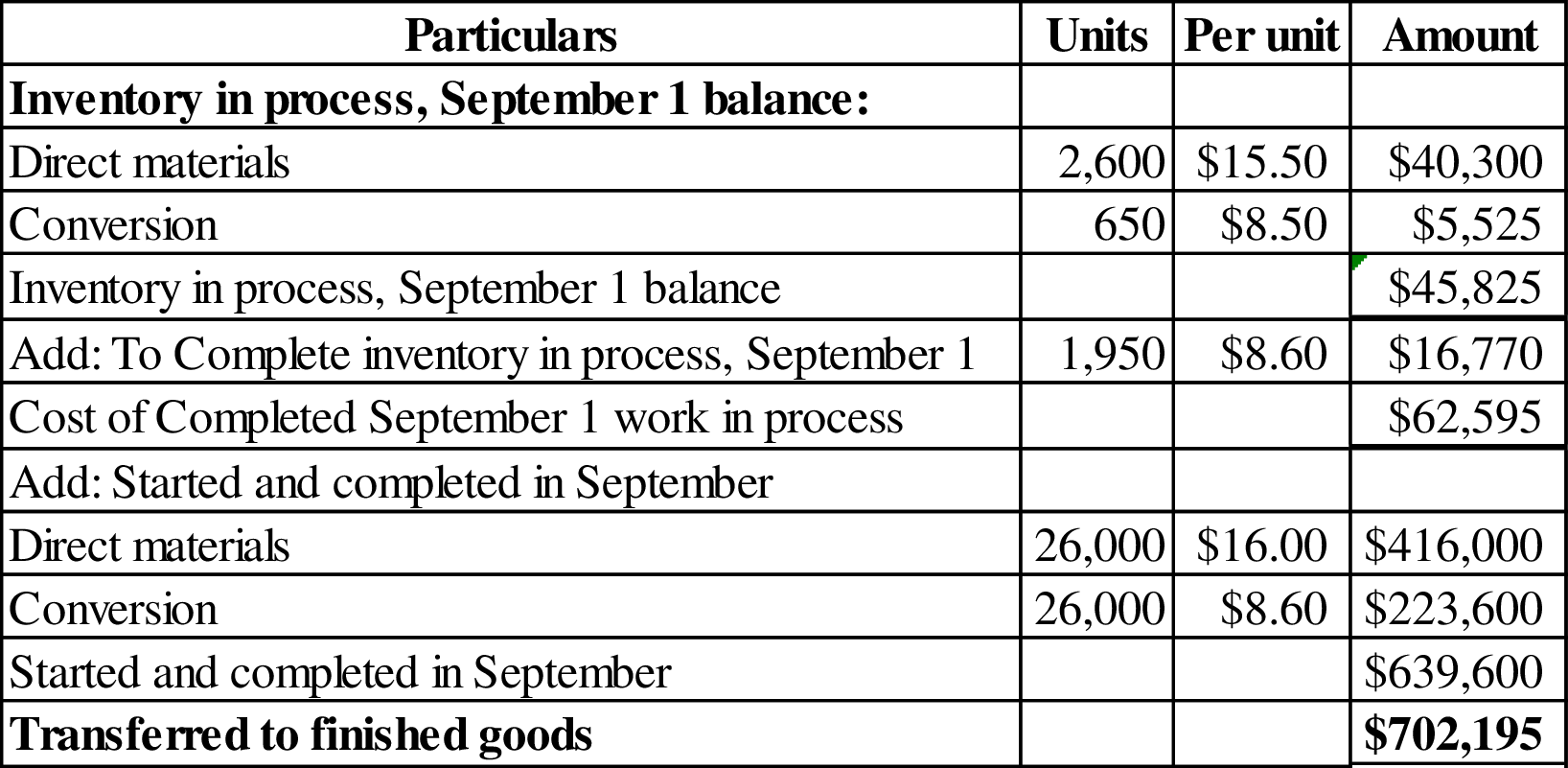
Figure (2)
Costs transferred to finished goods is calculated by adding opening inventory in September balance, to complete opening work in process inventory in September, andcost of units started and completed in September.
Hence, cost of completed work in process inventory in September 1 is $62,595, cost for started and completed in September is $639,600, and transferred to finished goods is $702,195.
(1)(D)
Prepare the ending work in process inventory cost of the month September for the Company PA.
Explanation of Solution
Prepare the ending work in process inventory cost of the month September for the Company PA as shown below:

Figure (3)
Ending work in process inventory cost is calculated by adding ending direct material cost and ending conversion costs.
Hence, ending work in process inventory cost for the month of September is $66,352.
Prepare the production cost report of rolling department for the month of September of Company PA.
Explanation of Solution
Prepare the production cost report of rolling department for the month of September for Company PA as shown below:
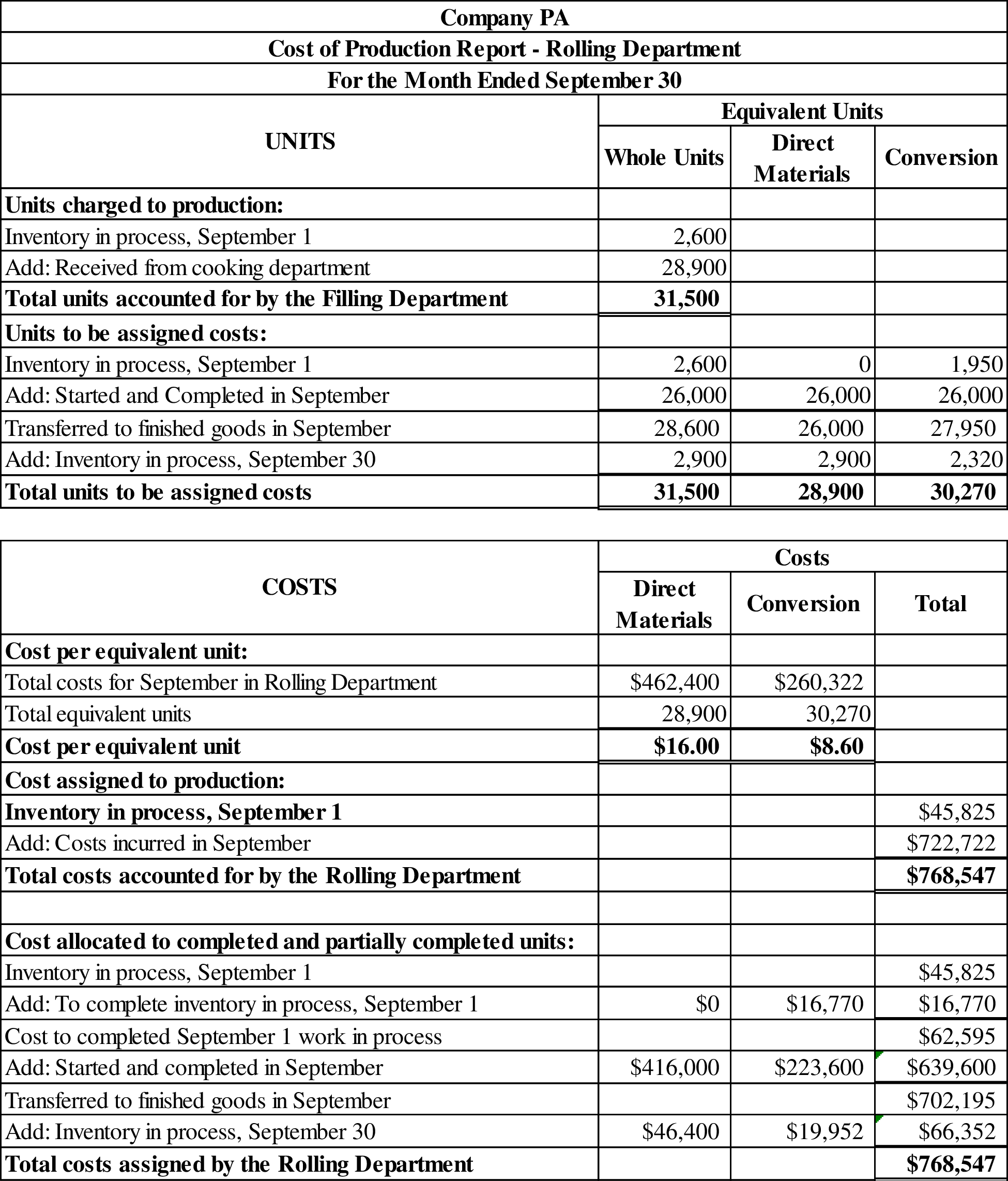
Figure (4)
Therefore, cost of production report for rolling department during the month of September for Company PA is $768,547.
(2) (A)
Prepare the equivalents units for production of direct materials and conversion cost during the month of October for Company PA.
Explanation of Solution
Prepare the equivalents units for production of direct materials and conversion cost during the month of October for Company PA as shown below:

Figure (5)
Working notes:
Calculate opening work in process inventory for conversion percentage to complete as shown below:
Calculate units started and completed in October as shown below:
Calculate ending work in process inventory units as shown below:
Total units to be assigned to costs is calculated by adding opening work in process inventory, units started and completed and ending work in process inventory.
Therefore, direct material equivalent units for production is 31,000 units and conversion cost equivalent units for production is 30,380 units.
(2) (B)
Prepare the cost per equivalent unit for direct material and conversion cost during the month of Octoberfor Company PA.
Explanation of Solution
Calculate the cost per equivalent unit for direct material and conversion cost during the month of October for Company PA as shown below:
Working note:
Calculate conversion cost for the month of September of Company PA as shown below:
Equivalent cost per unit for direct materials is calculated by dividing direct material cost by equivalent units for direct materials. Equivalent cost per unit for conversion cost is calculated by dividing conversion cost by equivalent units for conversion.
Therefore, equivalent cost per unit for direct material is $16.50 per unit and for conversion cost is $8.80 per unit.
(2) (C)
Prepare the cost of goods finished, between units stared in the prior period and units started and finished in October of Company PA.
Explanation of Solution
Prepare the cost of goods finished, between units stared in the prior period and units started and finished in October of Company PA as shown below:
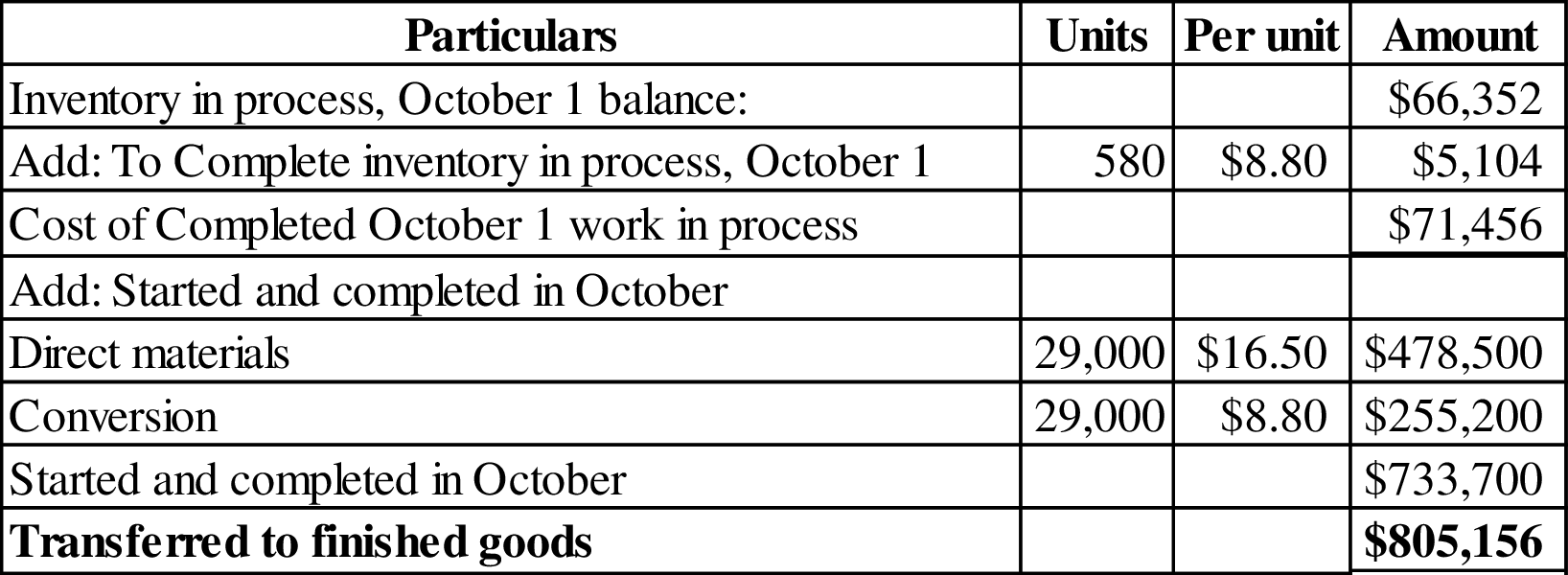
Figure (6)
Costs transferred to finished goods is calculated by adding opening inventory in September balance, to complete opening work in process inventory in September, and cost of units started and completed in September.
Hence, cost of completed work in process inventory in October 1 is $71,456, cost for started and completed in October is $733,700, and transferred to finished goods is $805,156.
(2) (D)
Prepare the ending work in process inventory cost of the month October for the Company PA.
Explanation of Solution
Prepare the ending work in process inventory cost of the month October for the Company PA as shown below:

Figure (7)
Ending work in process inventory cost is calculated by adding ending direct material cost and ending conversion costs.
Hence, ending work in process inventory cost for the month of October is $40,040.
Prepare the production cost report of rolling department for the month of October of Company PA.
Explanation of Solution
Prepare the production cost report of rolling department for the month of October of Company PA as shown below:
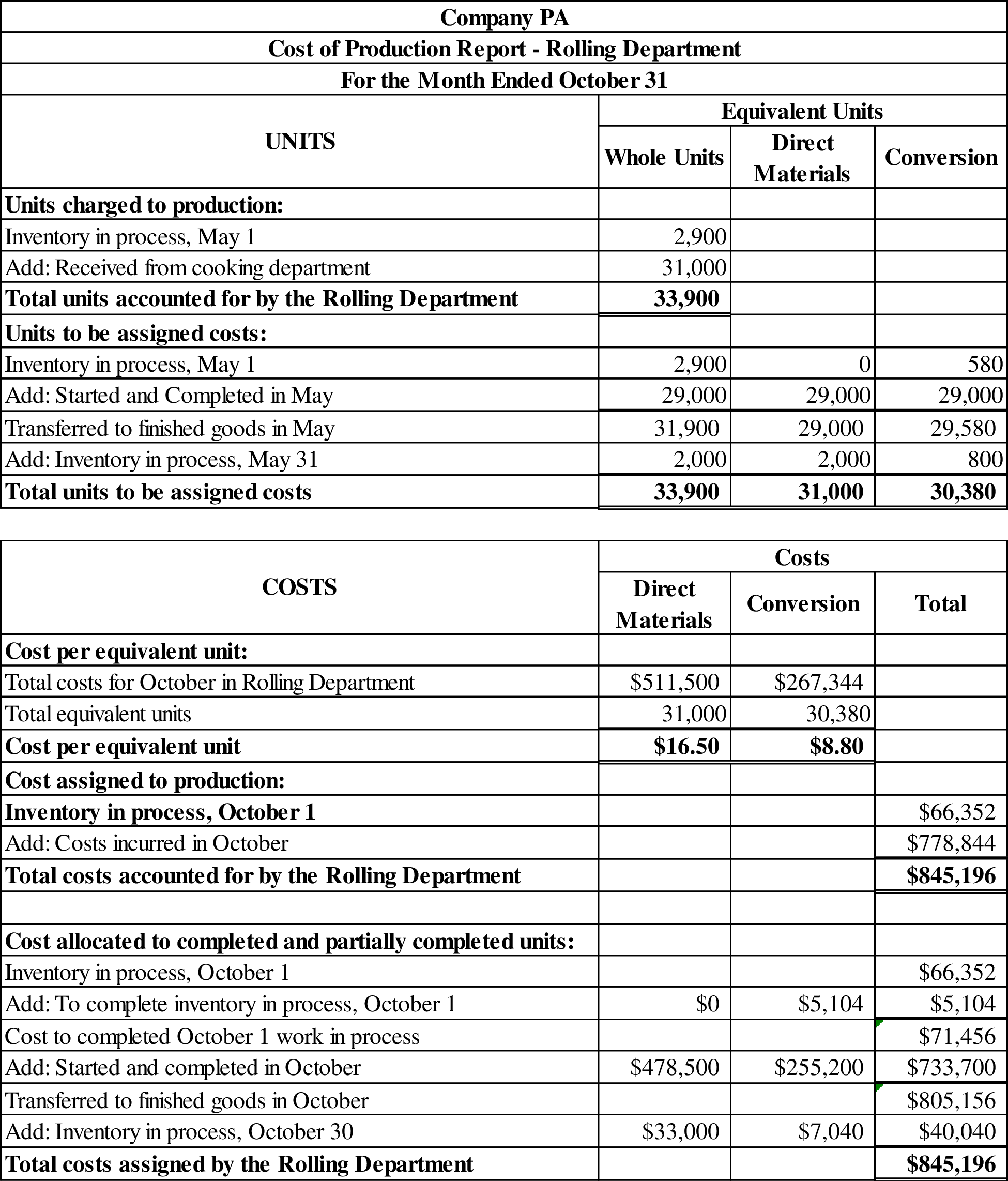
Figure (8)
Therefore, cost of production report for Rolling department during the month of October for Company PA is $845,196.
(3)
Mention the change in cost per equivalent unit for August through October for direct materials and conversion costs.
Explanation of Solution
The cost per equivalent unit for direct material in August is $15.50 per unit, in September is $16.00 per unit, and in October is $16.50 per unit. Constantly direct material cost per unit is increased from August to October. Likewise, the cost per equivalent unit for conversion cost in August is $8.50 per unit, in September is $8.60 per unit, and in October$8.80 per unit. Constantly conversion cost per unit is increased from August to October. The Company PA scrutinizes for their underlying reasons, and any required remedial actions would be taken.
Want to see more full solutions like this?
Chapter 3 Solutions
Managerial Accounting
- Work in process account data for two months; cost of production reports Hearty Soup Co. uses a process cost system to record the costs of processing soup, which requires the cooking and filling processes. Materials are entered from the cooking process at the beginning of the filling process. The inventory of Work in ProcessFilling on April 1 and debits to the account during April were as follows: During April, 800 units in process on April 1 were completed, and of the 7,800 units entering the department, all were completed except 550 units that were 90% completed. Charges to Work in ProcessFilling for May were as follows: During May, the units in process at the beginning of the month were completed, and of the 9,600 units entering the department, all were completed except 300 units that were 35% completed. Instructions 1. Enter the balance as of April 1, in a four-column account for Work in ProcessFilling. Record the debits and the credits in the account for April. Construct a cost of production report, and present computations for determining (A) equivalent units of production for materials and conversion, B) costs per equivalent unit, (C) cost of goods finished, differentiating between units started in the prior period and units started and finished in April, and (d) work in process inventory. 2. Provide the same information for May by recording the May transactions in the four-column work in process account. Construct a cost of production report, and present the May computations (A through D) listed in part (1). 3. Comment on the change in costs per equivalent unit for March through May for direct materials and conversion costs.arrow_forwardDublin Brewing Co. uses the process cost system. The following data, taken from the organizations books, reflect the results of manufacturing operations during October: Production Costs Work in process, beginning of period: Costs incurred during month: Production Data: 13,000 units finished and transferred to stockroom Work in process, end of period, 2,000 units one-half completed Required: Prepare a cost of production summary for October.arrow_forwardKraus Steel Company has two departments, Casting and Rolling. In the Rolling Department, ingots From the Casting Department are rolled into steel sheet. The Rolling Department received 4,000 tons from the Casting Department in October. During October, the Rolling Department completed 3,900 tons, including 200 tons of work in process on October 1. The ending work in process inventory on October 31 was 300 tons. How many tons were started and completed during October?arrow_forward
- Equivalent units and related costs; cost of production report; entries Dover Chemical Company manufactures specialty chemicals by a series of three processes, all materials being introduced in the Distilling Department. From the Distilling Department, the materials pass through the Reaction and Filling departments, emerging as finished chemicals. The balance in the account Work in ProcessFilling was as follows on January 1: The following costs were charged to Work in ProcessFilling during January: During January, 53,000 units of specialty chemicals were completed. Work in ProcessFilling Department on January 31 was 2,700 units, 30% completed. Instructions 1. Prepare a cost of production report for the Filling Department for January. 2. Journalize the entries for costs transferred from Reaction to Filling and the costs transferred from Filling to Finished Goods. 3. Determine the increase or decrease in the cost per equivalent unit from December to January for direct materials and conversion costs. 4. Discuss the uses of the cost of production report and the results of part (3).arrow_forwardKokomo Kayak Inc. uses the process cost system. The following data, taken from the organizations books, reflect the results of manufacturing operations during the month of March: Production Costs Work in process, beginning of period: Costs incurred during month: Production Data: 18,000 units finished and transferred to stockroom. Work in process, end of period, 3,000 units, two-thirds completed. Required: Prepare a cost of production summary for March.arrow_forwardCollegiate Publishing Inc. began printing operations on March 1. Jobs 301 and 302 were completed during the month, and all costs applicable to them were recorded on the related cost sheets. Jobs 303 and 304 are still in process at the end of the month, and all applicable costs except factory overhead have been recorded on the related cost sheets. In addition to the materials and labor charged directly to the jobs, 4,500 of indirect materials and 8,200 of indirect labor were used during the month. The cost sheets for the four jobs entering production during the month are as follows, in summary form: Journalize the summary entry to record each of the following operations for March (one entry for each operation): a. Direct and indirect materials used. b. Direct and indirect labor used. c. Factory overhead applied to all four jobs (a single overhead rate is used based on direct labor cost). d. Completion of Jobs 301 and 302.arrow_forward
- On December 1, Carmel Valley Production Inc. had a work in process inventory of 1,200 units that were complete as to materials and 50% complete as to labor and overhead. December 1 costs follow: During December the following transactions occurred: a. Purchased materials costing 50,000 on account. b. Placed direct materials costing 49,000 into production. c. Incurred production wages totaling 50,500. d. Incurred overhead costs for December: e. Applied overhead to work in process at a predetermined rate of 125% of direct labor cost. f. Completed and transferred 10,000 units to finished goods. (Hint: You should first compute equivalent units and unit costs. The unit cost should include applied, not actual, factory overhead.) Carmel Valley uses the weighted average cost method. The ending inventory of work in process consisted of 1,000 units that were completed as to materials and 25% complete as to labor and overhead. Required: Prepare the journal entries to record the above December transactions.arrow_forwardOverhead is assigned to the manufacturing department at the rate of $10 per machine hour. There were 3,500 machine hours during October in the shaping department and 2,500 in the packaging department. Prepare the journal entry to apply overhead to the manufacturing departments.arrow_forwardThe records of Stone Inc. reflect the following data: Work in process, beginning of month4,000 units one-fourth completed at a cost of 2,500 for materials, 1,400 for labor, and 1,800 for overhead. Production costs for the monthmaterials, 130,000; labor, 70,000; and factory overhead, 82,000. Units completed and transferred to stock45,000. Work in process, end of month5,000 units, one-half completed. Compute the months unit cost for each element of manufacturing cost and the total per unit cost. (Round unit costs to three decimal places.)arrow_forward
- During March, the following costs were charged to the manufacturing department: $22,500 for materials; $45,625 for labor; and $50,000 for manufacturing overhead. The records show that 40,000 units were completed and transferred, while 10,000 remained in ending inventory. There were 45,000 equivalent units of material and 42,500 units of conversion costs. Using the weighted-average method, prepare the companys process cost summary for the month.arrow_forwardThe following information concerns production in the Baking Department for December. All direct materials are placed in process at the beginning of production. a. Determine the number of units in work in process inventory at December 31. b. Determine the equivalent units of production for direct materials and conversion costs in December.arrow_forwardBaxter Company has two processing departments: Assembly and Finishing. A predetermined overhead rate of 10 per DLH is used to assign overhead to production. The company experienced the following operating activity for April: a. Materials issued to Assembly, 24,000 b. Direct labor cost: Assembly, 500 hours at 9.20 per hour; Finishing, 400 hours at 8 per hour c. Overhead applied to production d. Goods transferred to Finishing, 32,500 e. Goods transferred to finished goods warehouse, 20,500 f. Actual overhead incurred, 10,000 Required: 1. Prepare the required journal entries for the preceding transactions. 2. Assuming Assembly and Finishing have no beginning work-in-process inventories, determine the cost of each departments ending work-in-process inventories.arrow_forward
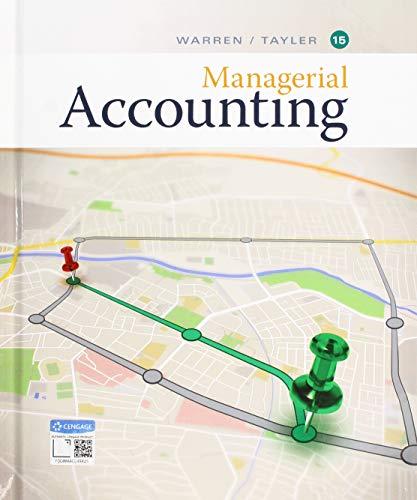 Managerial AccountingAccountingISBN:9781337912020Author:Carl Warren, Ph.d. Cma William B. TaylerPublisher:South-Western College Pub
Managerial AccountingAccountingISBN:9781337912020Author:Carl Warren, Ph.d. Cma William B. TaylerPublisher:South-Western College Pub Financial And Managerial AccountingAccountingISBN:9781337902663Author:WARREN, Carl S.Publisher:Cengage Learning,
Financial And Managerial AccountingAccountingISBN:9781337902663Author:WARREN, Carl S.Publisher:Cengage Learning,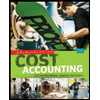 Principles of Cost AccountingAccountingISBN:9781305087408Author:Edward J. Vanderbeck, Maria R. MitchellPublisher:Cengage Learning
Principles of Cost AccountingAccountingISBN:9781305087408Author:Edward J. Vanderbeck, Maria R. MitchellPublisher:Cengage Learning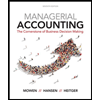 Managerial Accounting: The Cornerstone of Busines...AccountingISBN:9781337115773Author:Maryanne M. Mowen, Don R. Hansen, Dan L. HeitgerPublisher:Cengage Learning
Managerial Accounting: The Cornerstone of Busines...AccountingISBN:9781337115773Author:Maryanne M. Mowen, Don R. Hansen, Dan L. HeitgerPublisher:Cengage Learning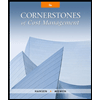 Cornerstones of Cost Management (Cornerstones Ser...AccountingISBN:9781305970663Author:Don R. Hansen, Maryanne M. MowenPublisher:Cengage Learning
Cornerstones of Cost Management (Cornerstones Ser...AccountingISBN:9781305970663Author:Don R. Hansen, Maryanne M. MowenPublisher:Cengage Learning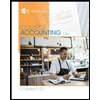 College Accounting, Chapters 1-27AccountingISBN:9781337794756Author:HEINTZ, James A.Publisher:Cengage Learning,
College Accounting, Chapters 1-27AccountingISBN:9781337794756Author:HEINTZ, James A.Publisher:Cengage Learning,





